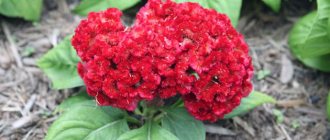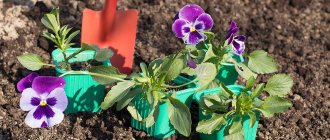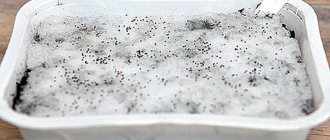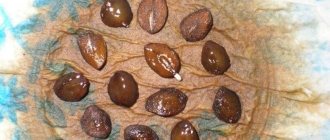Is it possible to grow raspberries from seeds at home?
When growing raspberries from seeds, follow the basic rules:
- use high-quality planting material, collected independently or purchased in a specialized store;
- choose the appropriate variety and time for sowing seeds;
- use a suitable soil mixture;
- dive on time;
- provide the seedlings with proper care.
Let's talk about each rule in more detail.
Important! High-quality raspberry seeds should be small and hard, oval-round in shape and yellowish-white in color.
Advantages and disadvantages of propagating raspberries by seeds
Advantages of the seed method of propagating raspberries:
- there is no need to prepare cuttings, which is important when propagating raspberry varieties from which it is difficult to select strong “offsprings”;
- the likelihood of obtaining another plant, unlike the mother one;
- saving time and money in the case of self-harvesting seeds.
Minuses:
- the need to create special conditions for seed germination;
- high probability of obtaining an unexpected result;
- the need for seedlings to comply with specific agrotechnical requirements.
Suitable varieties
Almost all varieties are suitable for growing from seeds, but those characterized by large fruits and a long fruiting period are especially popular. Also, when choosing, they are guided by the climatic conditions of the region, soil composition, ripening period of berries and yield.
The following varieties are suitable for planting in the central zone and southern regions of Russia:
- Polka. The variety is represented by medium-sized shrubs that are resistant to fungal diseases and viruses, but do not tolerate frost or excessively high temperatures. Fruiting - twice a year, yield - up to 4 kg per bush.
- Hercules. Spreading shrubs reaching a height of 2 m. Fruiting - twice a year, berries weigh about 6 g each, acidity is felt in the taste. Productivity – up to 3 kg per bush.
- Zyugana. The bushes are powerful, erect, do not need staking and have no thorns. Fruiting begins in July. The weight of the berries reaches 12 g, the yield is up to 9 kg per bush.
- Primara. The bushes are medium-sized, frost-resistant. The berries weigh on average 10 g and taste sour.
Varieties suitable for cultivation in northern regions:
- Bryansk miracle . Frost-resistant and high-yielding variety. The berries ripen in August. Productivity – up to 4 kg per bush.
- Caramel. Erect bushes that bear fruit from the first year. The berries are dense and sweet, reaching a weight of 12 g. Productivity is up to 5 kg per bush.
- Yellow giant. The bushes grow up to 2 m in height, the berries are yellow, each weighs about 8 g, and are characterized by a sweet taste and bright aroma. Productivity – up to 4 kg.
High-yielding raspberry varieties also include Patricia, Izobilnaya, Mirage, Red Ruby, and Gussar.
How to get seeds from raspberries
To independently collect seeds, berries are picked from the bush, thoroughly cleaned of debris, ground through a sieve, and the resulting cake is filled with water. Then all floating pulp and seeds unsuitable for sowing are removed, and the grains remaining at the bottom are washed several times with water and soaked for a day to swell.
Some gardeners dry the cake by spreading it in one thin layer on a cloth and leaving it in a bright, well-ventilated place.
Important! Seeds are collected only from fully ripened berries without rot or damage.
How to germinate them
It is also possible to sow ungerminated raspberry seeds, but preliminary preparation of planting material speeds up its germination and increases the chances of obtaining a positive result.
Germination allows you to get rid of seeds unsuitable for sowing and reduce the time for germination.
The seeds are laid between two layers of damp gauze and stored in a dark and warm place for 2-3 days. During this time, the gauze is regularly moistened to prevent it from drying out.
Successful germination is impossible without properly carried out stratification, that is, the creation of optimal conditions for the preparation of seed material. If sowing is planned to be done in the spring, the seeds are placed in a fabric or nylon bag, moistened and put in the refrigerator. The seed material is regularly sorted and ensured that it does not dry out.
Reference. The optimal temperature for stratification is +1…+5°C.
The process of planting raspberries depending on the time of year
The process of planting raspberries does not take very much time, but special attention must be paid to preparation, since the development of raspberries will depend on the soil in which it grows.
in spring
The procedure for planting raspberries does not change depending on the time of year, only the preparation for it changes. Before planting directly, you need to dig a hole; the size should be approximately 50 by 50.
Set the soil you dug aside and divide it into two parts; mix the first part with mineral fertilizer or nutrient mixture.
Do not forget that the distance between plants should be quite large, about half a meter.
Place the soil and fertilizer that you mixed earlier into the hole. If before you start planting raspberries, the soil has time to compact, then it should be loosened a little.
The raspberry seedling needs to be buried so that the replacement point is just below the surface level.
You also need to straighten the roots a little and cover them with the remaining soil. After you have buried the roots, compact the soil and dig a small hole around the seedling, it must be filled with water.
After the water is completely absorbed, fill the hole with humus or rotted sawdust. Also, it is necessary to trim the seedling so that its length does not exceed 30 cm.
If there is no rain for several days, you need to re-water.
in autumn
As mentioned earlier, the planting process in autumn and spring is no different, only the preparation for it is different.
Autumn is preferable because you have a lot of time to prepare; you don’t have to rush, but do everything gradually and measuredly.
Pay due attention to choosing a place and fertilizing the site, and then you can grow large and healthy raspberries that will bring you a lot of harvest.
You should also care for the seedlings, that is, regularly water, feed, remove weeds, and also hill up.
Other stages of preparation for sowing
Before germination, seeds are treated with a solution of fungicides (Alirin-B, Gamair) to minimize the risk of disease development, and with growth stimulants (Zircon, Kornevin) for speedy germination.
To germinate seeds and get strong and healthy plants, choose the right pots and substrate.
The container for sowing seeds should be maximum 15 cm deep. The best option is a special plastic pot for seedlings with drainage holes.
Raspberries prefer a substrate rich in nitrogen and potassium. To prepare soil suitable for seedlings, mix garden soil, peat and sand in equal proportions.
How to grow raspberries from seeds
Growing raspberry seedlings
Raspberry seeds, prepared in the fall, are planted in the soil in April. The soil must first be loosened and fertilized, and well moistened. However, excessive watering should not be allowed; this crop does not like too much water. In damp soil, raspberries grow poorly and develop poorly. The depth of planting the seeds is small - about 2-3 cm. They need to be sprinkled on top with a mixture of earth, sand and humus.
Autumn planting is also not excluded. In some cases this is even preferable. After all, this way the sprouts will be firmly established in the soil and undergo natural stratification. Remontant raspberry seeds are germinated in the same way.
When the grains have sprouted, they need to be thinned out and hilled. At the moment when the plants have produced 2-3 leaves, they can be planted. Young animals are best kept in a greenhouse, in specially prepared soil. The ground needs to be periodically weeded from weeds, the plants are watered every five to seven days, sometimes they are fed, disease prevention is carried out and protection from pests is provided.
There is another way to grow raspberry bushes from seeds. It is less troublesome, but with unproven effectiveness. It consists of generously coating a thick jute rope with berries, after which it is moved 2-3 cm into the soil. As in the case of ordinary seeds, the ground must be prepared by mixing it with peat in a ratio of 50/50 or in equal parts with sand and humus.
Timing for planting seeds
Seeds for seedlings are sown in the first week of March. In autumn (September - October) they are sown immediately in open ground. However, in both cases there are advantages and disadvantages.
Advantages of spring sowing:
- the ability to use only high-quality seeds in case of pre-germination;
- providing seedlings with proper care when grown in a greenhouse or indoors;
- the possibility of planting seedlings in the ground immediately after the end of frost.
Minuses:
- the need of sprouts for additional lighting;
- the need for proper conditions for storing seeds;
- risk of root damage during transplantation.
When sowing in autumn, there is no need to grow seedlings, store seed material and create special conditions for stratification. Young plants are more resilient; they are not replanted, so there is no risk of damage to the roots.
At the same time, it is impossible to predict how many seeds the sprouts will produce, and some young plants die due to spring frosts.
How to grow raspberries in winter. Growing raspberries all year round - myth or reality?
A set of available industrial raspberry varieties of summer and autumn fruiting allows you to create a berry conveyor for supplying fresh products to the market from the end of June until autumn frosts.
In remontant raspberry varieties, fruiting can be accelerated by 10-14 days by covering the rows with agrofibre in early spring. The created microclimate allows you to accelerate the regrowth of young shoots. The cover is removed when the plants reach a height of 30-40 cm.
Reducing the width of the productive strip somewhat accelerates the ripening of the crop. Application of increased doses of nitrogen fertilizers, on the contrary, can lead to a delay in fruiting by several weeks.
When using a frame shelter in the form of a high tunnel covered with plastic film, you can get the production of summer raspberry varieties several weeks earlier and continue collecting berries from remontant varieties almost until the end of November.
You can extend the supply of raspberries under film cover by growing late varieties of remontant raspberries with a long fruiting period, and using various agrotechnical methods to delay the flowering period (burning the first wave of shoots with contact herbicides or pinching the tops).
Abundant fruiting of raspberries in a film frame tunnel
It is promising to grow raspberries in heated greenhouses to produce berries in winter and early spring. Currently, the volume of this market is small, but there is a steady trend towards its increase. In winter, there are a lot of fresh vegetables and fruits, which are more economically feasible to import from subtropical countries, but exporters practically do not import fresh raspberries. The main reason for this is the relatively short shelf life of berries and the low transportability of such products.
Mulching between rows of young plantings in a greenhouse with film and organic mulch materials
Often, greenhouses used for growing seedlings or early spring vegetables in winter remain empty. Unlike most other indoor crops, raspberries do not require additional lighting (if you plan to harvest from February-March) and can be successfully grown at relatively low temperatures (18-20°C). Products obtained in greenhouses are usually of better quality - the berries are larger in size, dense and have a longer shelf life.
High-quality raspberries grown using intensive technology
To obtain products in greenhouses, raspberry varieties of the traditional fruiting type are usually used. To do this, in the spring, plants are planted in containers with a capacity of 12-20 liters in a well-drained substrate. The substrate can consist of 2 parts peat, 2 parts vermiculite and 1 part sand. For every 1000 liters of substrate, add macroelements (600 g of calcium nitrate and double superphosphate, and 2.5 -3.0 kg of lime) and fertilizers with microelements. The reaction of the substrate solution should be in the range of 5.5 - 6.5.
Growing summer (traditional) raspberry varieties with a closed root system
Plants in containers are grown in open ground using drip irrigation with fertigation. A distance of 2.5 - 3.0 m is left between the rows for better lighting, which will facilitate the laying of generative buds in the lower part of the shoot. Be sure to use a trellis to ensure sufficient stability of the containers and to avoid damage to the shoots.
Fruiting raspberries and new growth with a closed root system in a greenhouse
In the fall, reduce the intensity of watering and stop applying nitrogen fertilizers so that the plants are better prepared for winter. To awaken the generative buds, raspberries need a period of low temperatures (below +5°C) for 800-900 hours. The easiest way is to leave containers with plants outside, insulating the root system with bales of straw. The root system has lower frost resistance than the shoots themselves, and therefore you need to constantly check that the temperature in the containers does not drop below -6°C. If the plants have not fully accumulated enough hours of field cooling, when they are moved to the greenhouse, the generative buds will not wake up, or will only wake up on the top of the shoot (buds that are placed lower and on thick shoots may require up to 1000 hours of low temperatures). Plants can be placed in a refrigerator to complete the cooling period, but fruits that produce ethylene should not be stored in the refrigerator. You can also store containers with plants in greenhouses with the heating turned off, making sure that the temperature does not rise above +5°C.
Landing technology
Seed planting scheme:
- pour a suitable soil mixture into previously prepared containers;
- distribute raspberry seeds over the surface of the substrate, deepening them by 0.5-0.7 cm;
- sprinkle them with sand;
- cover the container with polyethylene and put it in a bright place, excluding direct sunlight.
The process of planting seedlings:
- in a pre-prepared area, dig planting holes at a distance of at least 15 cm from each other;
- pour 100 g of ash and humus into the bottom of each hole;
- moisten the container with seedlings;
- remove the seedlings from the container, place them in the center of the holes;
- sprinkle with soil, lightly compact it and water.
Seedlings are transplanted into open ground when the average daily air temperature reaches +15...+18°C.
Raspberry transplant
Raspberry transplantation is carried out according to the same scheme as the initial planting. Transplantation can be done at any time of the year, except winter. Preferably in spring, so that the raspberries do not spread, dig sheets of iron around the perimeter.
Raspberry propagation
Raspberry propagation is not a very difficult matter; it can be propagated by suckers and cuttings. It is quite easy to propagate raspberries with them. To do this, cut cuttings approximately 10 cm long from two-year-old offspring.
Then place them in a container with a root formation stimulator for 12 hours, and then plant them in containers with soil and cover with film. Maintain the temperature 22-24 degrees.
After the cuttings take root, they need to be transplanted into a larger container and gradually accustomed to being outside.
As soon as the cuttings begin to get used to being in the open air, they need to be planted in a permanent place.
If you make cuttings in the fall, then they need to be sprayed with a disinfecting solution.
Raspberry propagation by cuttings
Further care
When watering seedlings, they are guided by the condition of the top layer of soil - it should not be allowed to dry out completely . The earth is watered with water at room temperature on average once every 3-5 days. Fertilizers in the form of a urea solution are applied every 10 days.
After planting the seedlings in the ground, pay close attention to ensure that the soil does not dry out. This is the main requirement for caring for raspberries during the first two seasons.
Plantings are also weeded and loosened weekly - this improves soil moisture permeability and aeration.
Fertilizers are applied after the snow melts (urea or saltpeter), after loosening (compost or peat - 0.5 buckets per 1 sq. m), in May (mullein solution 1:4) and during the period of ovary formation (60 g per 10 liters of water superphosphate and 10 g of urea).
Important! All fertilizing is applied only after loosening and watering.
To prevent infections in rainy weather, plants are sprayed with a solution of Bordeaux mixture twice a month.
Stages of growing seedlings before planting in the ground
The first shoots appear 20-25 days after sowing the seeds, which must be preceded by selection, germination and processing.
If the planting material was sown frequently, after 1-2 true leaves appear on the sprouts, the seedlings are planted in separate containers. Otherwise, the plants will not receive enough light and will slow down in development.
A few weeks before planting in the ground, seedlings begin to harden off. To do this, the container with the seedlings is taken out onto the balcony or street, first for 10 minutes, gradually increasing this time.
When the seedlings have 2-4 leaves, they are planted in the ground.
Methods for planting raspberry bushes
Raspberries are one of the most popular berry crops, so there are many ways to plant them. You can find their description below.
Bush
This method involves planting raspberry bushes; it is the most common; many gardeners and gardeners use it.
In this case, preliminary soil preparation is not necessary; all fertilizers are applied directly during sowing. You can also plant a lot of bushes, even if you don't have room for a large raspberry tree.
The scheme of action is the same as with seedlings, you just need to pay attention to marking the rows. The distance between rows should be more than one meter, and between plants more than 80 cm.
Rows of raspberries in a summer cottage
Trench
By planting raspberries this way, you increase the yield of the raspberry tree, but it is more labor-intensive and time-consuming. It is great for growing raspberries in large quantities or for industrial production.
It is necessary to mark the site using a peg with a rope; a trench is dug using the markings. The distance between trenches should be more than 1.2 meters. For more accurate markings, you need to work together.
Container
This method is perfect for gardeners who don’t have any room for raspberries, but really want to plant them.
To do this, you need a container with a diameter of half a meter and a height of approximately 60 cm, but it should not have a bottom. The container needs to be filled with fertile soil and dug into the ground.
This way, the walls of the dish prevent the raspberries from growing too much, thereby saving precious space.
A raspberry bush planted in a container saves oil on the site and looks aesthetically pleasing
In tires
This is a very interesting method, which also helps raspberries not to grow; old, but thick tires are suitable for planting in this way. The planting process is the same as container planting.
The advantage of this type of planting is that the raspberry bushes look like miniature flower beds that add charm to your garden.
Tires prevent raspberry roots from spreading throughout the area
Tape
This method is similar to the bush method, only the plants themselves are planted much closer to each other, and on the contrary, the distance between the rows is increased. This method allows you to speed up fruiting and increase productivity .
Despite the fact that the yield of raspberries increases several times, it becomes very difficult to care for them, since the plants are very close to each other.
Raspberry is an unpretentious plant that produces a harvest even in desolation. With good care it produces a bountiful harvest.
On the trellis
There are some varieties that can grow up to 3 meters in length, and due to their large growth, they can break. This can happen due to wind or a harvest that is too heavy.
In this case, they can be supported by a trellis. It must be installed together with the raspberry plant and preferably before the first leaves appear. Trellis must be installed along the edges of the trench.
Under film
The raspberry root system is superficial, which means that it does not tolerate drying out of the soil, so it is important to mulch raspberries. Nowadays they use not only sawdust, but also film, as well as agrofabric.
The idea is that the film is fixed around the entire perimeter of the area and holes are made into which the raspberries are planted. It is also necessary to provide a drip irrigation system.
Mulching raspberry plantings with agro-fabric prevents the roots from drying out and weeds
Advice from experienced gardeners
Experienced gardeners recommend:
- collect raspberry seeds in September - this is the optimal harvesting time;
- Use only large, ripe, undamaged berries to collect grains and make sure that the bush itself is healthy;
- after planting seedlings in spring, mulch the soil around the holes with sawdust;
- cover seedlings if frost is expected.
Pests and diseases
No matter how well you take care of your plantings, it is not always possible to get a rich harvest: there will be those “who want to feast on” fresh fruits, flowers, leaves and even plant stems. We are talking about various insects. Raspberry beetles, raspberry-strawberry weevils, stem gall midges, aphids, and bud moths can not only significantly reduce the yield, but also damage the plants themselves and lead to their death. You can, of course, collect insects and their larvae by hand, but it is better to follow the rules of agricultural technology (loosen the soil, remove weeds, promptly prune affected shoots), and also use specialized pest control products.
Various diseases also cause damage to plants. Raspberries are characterized by problems such as:
- rust;
- curliness;
- chlorosis.
In addition to such control methods as applying fertilizers, spraying with a solution of Bordeaux mixture and other chemicals, an effective means of combating the disease is pruning the affected plants. Shoots severely damaged by disease and pest attacks are carefully cut off with pruning shears and burned.
“Raspberry tree” is a winter-hardy plant, so in regions with heavy snowfall it is not necessary to cover the plantings for the winter. If in your area the winters are snowless and temperature fluctuations are significant, then you need to make sure that the raspberries are comfortable even in the cold season. To do this, only young bushes are left on the site, and mature, fruit-bearing plants are cut off. After leaf fall, the stems are carefully bent, secured and covered with covering material. In winter, these structures need to be covered with snow periodically.











